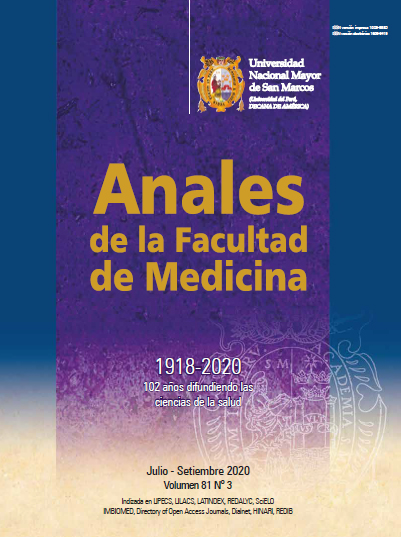Factors associated with lack of treatment adherence in glaucoma patients
DOI:
https://doi.org/10.15381/anales.v81i3.19464Keywords:
Epidemiologic Factors, Treatment Adherence and Compliance, GlaucomaAbstract
Objective. Was to determine the factors associated with the lack of adherence to ophthalmological treatment in patients with glaucoma, at a private clinic. Methods. Observational, analytical and crosssectional design. The sample consisted of 106 patients with a previous diagnosis of glaucoma. The statistical analysis was carried out with STATAv.16., the Student’s t test, the Chi square test and the logistic regression analysis were performed with a level of significance of 5%. Results. The average age of the patients was 66,6 ± 13,8 years, the majority were women (59,43%), from the coast (62,26%), with a high school degree education (38,68). The frequency of poor adherence to ophthalmological treatment was 69,81% (n = 74). The multivariate logistic regression analysis revealed that accessibility to medications (OR = 0,10; 95% CI = 0,03-0,32) and compliance with the time of medication (OR = 0,09; 95% CI = 0,02- 0,33) represent protective factors of poor adherence to treatment, while the interruption of medication due to feeling good in health (OR = 9,23; 95% CI = 1,08-78,52), needing help to place the drops (OR = 2,61; 95% CI = 1,10-6,20) and stopping treatment if help is not found (OR = 4,43; 95% CI = 1,19-16,25) represent risk factors for poor adherence to ophthalmological treatment. Conclusion. Glaucoma patients without access to medications, who fail to adhere to their medication schedule, who interrupt their medication because they feel good, who need help in their care and cannot find help are more prone to poor adherence to ophthalmological treatment.
Downloads
Published
Issue
Section
License
Copyright (c) 2020 Anales de la Facultad de Medicina

This work is licensed under a Creative Commons Attribution-NonCommercial-ShareAlike 4.0 International License.
Those authors who have publications with this magazine accept the following terms:
- Authors will retain their copyrights and guarantee the journal the right of first publication of their work, which will be simultaneously subject to Creative Commons Attribution License that allows third parties to share the work as long as its author and its first publication this magazine are indicated.
- Authors may adopt other non-exclusive licensing agreements for the distribution of the version of the published work (eg, deposit it in an institutional electronic file or publish it in a monographic volume) provided that the initial publication in this magazine is indicated.
- Authors are allowed and recommended to disseminate their work over the Internet (eg: in institutional telematic archives or on their website) before and during the submission process, which It can produce interesting exchanges and increase quotes from the published work. (See El efecto del acceso abierto ).



